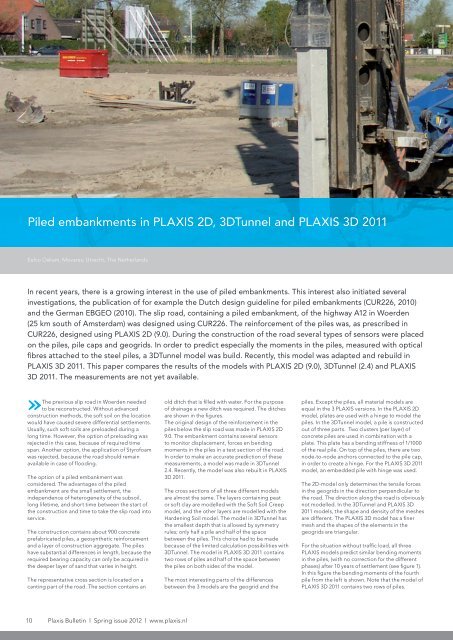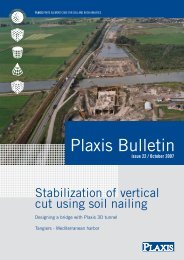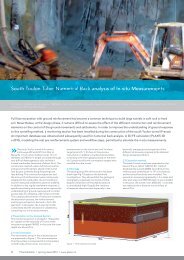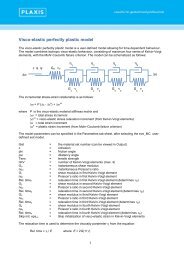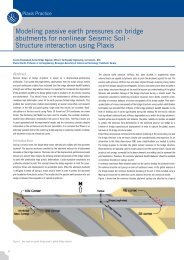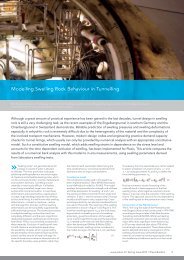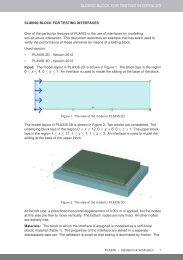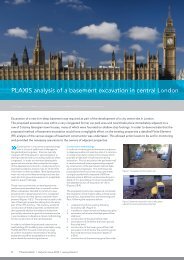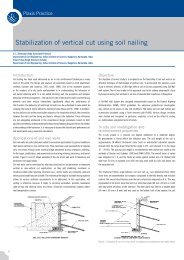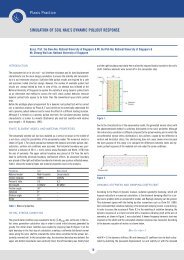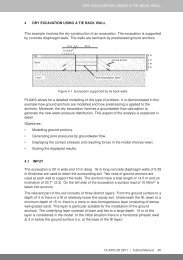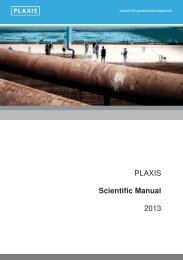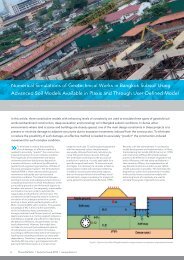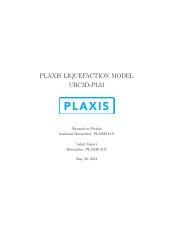Piled embankments in PLAXIS 2D, 3DTunnel and PLAXIS 3D 2011
Piled embankments in PLAXIS 2D, 3DTunnel and PLAXIS 3D 2011
Piled embankments in PLAXIS 2D, 3DTunnel and PLAXIS 3D 2011
You also want an ePaper? Increase the reach of your titles
YUMPU automatically turns print PDFs into web optimized ePapers that Google loves.
<strong>Piled</strong> <strong>embankments</strong> <strong>in</strong> <strong>PLAXIS</strong> <strong>2D</strong>, <strong><strong>3D</strong>Tunnel</strong> <strong>and</strong> <strong>PLAXIS</strong> <strong>3D</strong> <strong>2011</strong><br />
Eelco Oskam, Movares, Utrecht, The Netherl<strong>and</strong>s<br />
In recent years, there is a grow<strong>in</strong>g <strong>in</strong>terest <strong>in</strong> the use of piled <strong>embankments</strong>. This <strong>in</strong>terest also <strong>in</strong>itiated several<br />
<strong>in</strong>vestigations, the publication of for example the Dutch design guidel<strong>in</strong>e for piled <strong>embankments</strong> (CUR226, 2010)<br />
<strong>and</strong> the German EBGEO (2010). The slip road, conta<strong>in</strong><strong>in</strong>g a piled embankment, of the highway A12 <strong>in</strong> Woerden<br />
(25 km south of Amsterdam) was designed us<strong>in</strong>g CUR226. The re<strong>in</strong>forcement of the piles was, as prescribed <strong>in</strong><br />
CUR226, designed us<strong>in</strong>g <strong>PLAXIS</strong> <strong>2D</strong> (9.0). Dur<strong>in</strong>g the construction of the road several types of sensors were placed<br />
on the piles, pile caps <strong>and</strong> geogrids. In order to predict especially the moments <strong>in</strong> the piles, measured with optical<br />
fibres attached to the steel piles, a <strong><strong>3D</strong>Tunnel</strong> model was build. Recently, this model was adapted <strong>and</strong> rebuild <strong>in</strong><br />
<strong>PLAXIS</strong> <strong>3D</strong> <strong>2011</strong>. This paper compares the results of the models with <strong>PLAXIS</strong> <strong>2D</strong> (9.0), <strong><strong>3D</strong>Tunnel</strong> (2.4) <strong>and</strong> <strong>PLAXIS</strong><br />
<strong>3D</strong> <strong>2011</strong>. The measurements are not yet available.<br />
The previous slip road <strong>in</strong> Woerden needed<br />
» to be reconstructed. Without advanced<br />
construction methods, the soft soil on the location<br />
would have caused severe differential settlements.<br />
Usually, such soft soils are preloaded dur<strong>in</strong>g a<br />
long time. However, the option of preload<strong>in</strong>g was<br />
rejected <strong>in</strong> this case, because of required time<br />
span. Another option, the application of Styrofoam<br />
was rejected, because the road should rema<strong>in</strong><br />
available <strong>in</strong> case of flood<strong>in</strong>g.<br />
The option of a piled embankment was<br />
considered. The advantages of the piled<br />
embankment are the small settlement, the<br />
<strong>in</strong>dependence of heterogeneity of the subsoil,<br />
long lifetime, <strong>and</strong> short time between the start of<br />
the construction <strong>and</strong> time to take the slip road <strong>in</strong>to<br />
service.<br />
The construction conta<strong>in</strong>s about 900 concrete<br />
prefabricated piles, a geosynthetic re<strong>in</strong>forcement<br />
<strong>and</strong> a layer of construction aggregate. The piles<br />
have substantial differences <strong>in</strong> length, because the<br />
required bear<strong>in</strong>g capacity can only be acquired <strong>in</strong><br />
the deeper layer of s<strong>and</strong> that varies <strong>in</strong> height.<br />
The representative cross section is located on a<br />
cant<strong>in</strong>g part of the road. The section conta<strong>in</strong>s an<br />
old ditch that is filled with water. For the purpose<br />
of dra<strong>in</strong>age a new ditch was required. The ditches<br />
are shown <strong>in</strong> the figures.<br />
The orig<strong>in</strong>al design of the re<strong>in</strong>forcement <strong>in</strong> the<br />
piles below the slip road was made <strong>in</strong> <strong>PLAXIS</strong> <strong>2D</strong><br />
9.0. The embankment conta<strong>in</strong>s several sensors<br />
to monitor displacement, forces en bend<strong>in</strong>g<br />
moments <strong>in</strong> the piles <strong>in</strong> a test section of the road.<br />
In order to make an accurate prediction of these<br />
measurements, a model was made <strong>in</strong> <strong><strong>3D</strong>Tunnel</strong><br />
2.4. Recently, the model was also rebuilt <strong>in</strong> <strong>PLAXIS</strong><br />
<strong>3D</strong> <strong>2011</strong>.<br />
The cross sections of all three different models<br />
are almost the same. The layers conta<strong>in</strong><strong>in</strong>g peat<br />
or soft clay are modelled with the Soft Soil Creep<br />
model, <strong>and</strong> the other layers are modelled with the<br />
Harden<strong>in</strong>g Soil model. The model <strong>in</strong> <strong><strong>3D</strong>Tunnel</strong> has<br />
the smallest depth that is allowed by symmetry<br />
rules; only half a pile <strong>and</strong> half of the space<br />
between the piles. This choice had to be made<br />
because of the limited calculation possibilities with<br />
<strong><strong>3D</strong>Tunnel</strong>. The model <strong>in</strong> <strong>PLAXIS</strong> <strong>3D</strong> <strong>2011</strong> conta<strong>in</strong>s<br />
two rows of piles <strong>and</strong> half of the space between<br />
the piles on both sides of the model.<br />
The most <strong>in</strong>terest<strong>in</strong>g parts of the differences<br />
between the 3 models are the geogrid <strong>and</strong> the<br />
piles. Except the piles, all material models are<br />
equal <strong>in</strong> the 3 <strong>PLAXIS</strong> versions. In the <strong>PLAXIS</strong> <strong>2D</strong><br />
model, plates are used with a h<strong>in</strong>ge to model the<br />
piles. In the <strong><strong>3D</strong>Tunnel</strong> model, a pile is constructed<br />
out of three parts. Two clusters (per layer) of<br />
concrete piles are used <strong>in</strong> comb<strong>in</strong>ation with a<br />
plate. This plate has a bend<strong>in</strong>g stiffness of 1/1000<br />
of the real pile. On top of the piles, there are two<br />
node-to-node anchors connected to the pile cap,<br />
<strong>in</strong> order to create a h<strong>in</strong>ge. For the <strong>PLAXIS</strong> <strong>3D</strong> <strong>2011</strong><br />
model, an embedded pile with h<strong>in</strong>ge was used.<br />
The <strong>2D</strong>-model only determ<strong>in</strong>es the tensile forces<br />
<strong>in</strong> the geogrids <strong>in</strong> the direction perpendicular to<br />
the road. The direction along the road is obviously<br />
not modelled. In the <strong><strong>3D</strong>Tunnel</strong> <strong>and</strong> <strong>PLAXIS</strong> <strong>3D</strong><br />
<strong>2011</strong> models, the shape <strong>and</strong> density of the meshes<br />
are different. The <strong>PLAXIS</strong> <strong>3D</strong> model has a f<strong>in</strong>er<br />
mesh <strong>and</strong> the shapes of the elements <strong>in</strong> the<br />
geogrids are triangular.<br />
For the situation without traffic load, all three<br />
<strong>PLAXIS</strong> models predict similar bend<strong>in</strong>g moments<br />
<strong>in</strong> the piles, (with no correction for the different<br />
phases) after 10 years of settlement (see figure 1).<br />
In this figure the bend<strong>in</strong>g moments of the fourth<br />
pile from the left is shown. Note that the model of<br />
<strong>PLAXIS</strong> <strong>3D</strong> <strong>2011</strong> conta<strong>in</strong>s two rows of piles.<br />
10 Plaxis Bullet<strong>in</strong> l Spr<strong>in</strong>g issue 2012 l www.plaxis.nl
For the situation with traffic load, it appears that<br />
the bend<strong>in</strong>g moments <strong>in</strong> the <strong><strong>3D</strong>Tunnel</strong> model<br />
are smaller than the two other predictions, <strong>and</strong><br />
probably not realistic. This difference is <strong>in</strong>itiated<br />
<strong>in</strong> the start of the phases with updated mesh.<br />
The updated mesh is required to properly model<br />
the membrane effect <strong>in</strong> the geogrid. Dur<strong>in</strong>g the<br />
excavation, the bottom of the excavation shows a<br />
heave. When the piles are activated, a pre-stress<br />
occurs. This is the ma<strong>in</strong> cause for the smaller<br />
bend<strong>in</strong>g moments. For the same reason, a large<br />
bend<strong>in</strong>g moment <strong>in</strong> the model of <strong>PLAXIS</strong> <strong>2D</strong> is<br />
present at -19m, but for this model correction is<br />
possible. S<strong>in</strong>ce the piles consist of one type of<br />
l<strong>in</strong>ear elements.<br />
Figures 1 <strong>and</strong> 2 show the tensile forces <strong>in</strong> the<br />
geogrids, <strong>in</strong> the directions perpendicular to the<br />
road. It should be noted that CUR226 predicts a<br />
maximum tensile force along the road of 96 kN/m,<br />
<strong>and</strong> across the road of 112 kN/m. This agrees very<br />
well with the <strong>3D</strong> predictions.<br />
The differences between the <strong>PLAXIS</strong> models do<br />
not <strong>in</strong>crease when the load is applied. The plots<br />
of the forces <strong>in</strong> the geogrids show that all <strong>PLAXIS</strong><br />
models, <strong>and</strong> especially <strong>PLAXIS</strong> <strong>2D</strong>, give peaks at<br />
the sides of the pile caps (these peaks decrease<br />
when the element sizes are reduced further), but<br />
generally, the maximum forces are similar to the<br />
<strong>PLAXIS</strong> <strong>3D</strong> model. The forces <strong>in</strong> the geogrids<br />
<strong>in</strong> the <strong>3D</strong> models are similar, but the <strong>PLAXIS</strong> <strong>3D</strong><br />
<strong>2011</strong> version gives higher values, especially <strong>in</strong> the<br />
direction parallel to the road.<br />
It can be concluded that <strong>PLAXIS</strong> <strong>3D</strong> <strong>2011</strong> is better<br />
suitable for modell<strong>in</strong>g piles than <strong><strong>3D</strong>Tunnel</strong> <strong>and</strong><br />
gives very promis<strong>in</strong>g results. The most important<br />
improvement <strong>in</strong> <strong>PLAXIS</strong> <strong>3D</strong> <strong>2011</strong> is the embedded<br />
pile, s<strong>in</strong>ce the bend<strong>in</strong>g moment <strong>and</strong> <strong>in</strong>itial stra<strong>in</strong> of<br />
the piles <strong>in</strong> the <strong>in</strong>stallation phase of the piles (with<br />
updated mesh) are less disturbed. The modell<strong>in</strong>g<br />
<strong>in</strong> <strong>PLAXIS</strong> <strong>3D</strong> <strong>2011</strong> is also easier <strong>and</strong> faster than the<br />
modell<strong>in</strong>g <strong>in</strong> <strong><strong>3D</strong>Tunnel</strong>.<br />
In the near future, the calculations results of the<br />
calculations will be compared to the measured<br />
data.<br />
References<br />
• CUR 226, 2010. Ontwerprichtlijn paalmatrassystemen<br />
(Design guidel<strong>in</strong>e piled <strong>embankments</strong>),<br />
ISBN 978-90-376-0518-1 (<strong>in</strong> Dutch).<br />
• EBGEO, 2010. Empfehlungen für den Entwurf<br />
und die Berechnung von Erdkörpern mit<br />
Bewehrungen aus Geokunststoffen – EBGEO,<br />
2. Auflage, German Geotechnical Society, ISBN<br />
978-3-433-02950-3 (<strong>in</strong> German). Also available<br />
<strong>in</strong> English: Recommendations for Design <strong>and</strong><br />
Analysis of Earth Structures us<strong>in</strong>g Geosynthetic<br />
Re<strong>in</strong>forcements – EBGEO, <strong>2011</strong>. ISBN<br />
978-3-433-02983-1 <strong>and</strong> digital <strong>in</strong> English ISBN<br />
978-3-433-60093-1).<br />
<strong>PLAXIS</strong> <strong>2D</strong> <strong><strong>3D</strong>Tunnel</strong> <strong>PLAXIS</strong> <strong>3D</strong><br />
Figure 1: Bend<strong>in</strong>g moment <strong>in</strong> pile, without traffic load<strong>in</strong>g<br />
Figure 2: Force <strong>in</strong> geogrid, with traffic load<strong>in</strong>g<br />
www.plaxis.nl l Spr<strong>in</strong>g issue 2012 l Plaxis Bullet<strong>in</strong> 11


